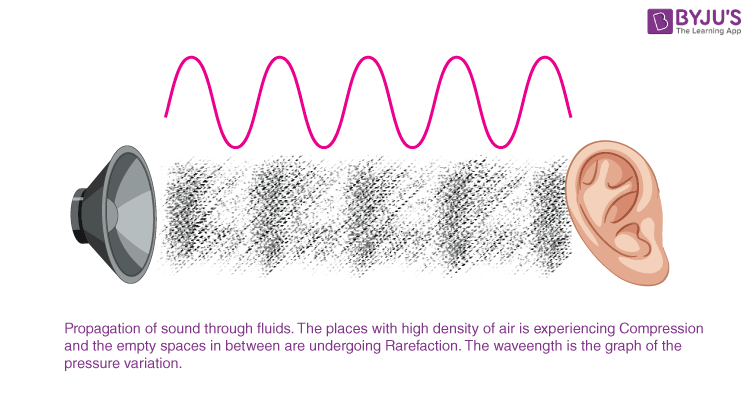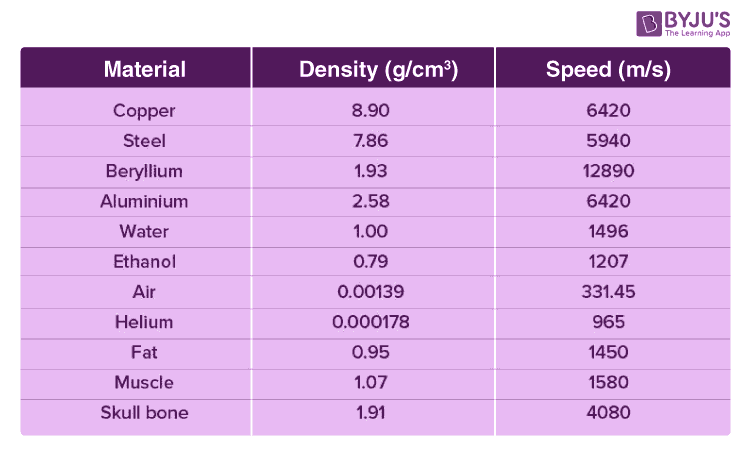A sound wave is fundamentally a pressure disturbance that propagates through a medium by particle interaction. In other words, sound waves move through a physical medium by alternately contracting and expanding the section of the medium in which it propagates. The rate at which the sound waves propagate through the medium is known as the speed of sound. In this article, you will discover the definition and factors affecting the speed of sound.
|
Table of Contents |
Speed of Sound Definition
The speed of sound is defined as the distance through which a sound wave’s point, such as a compression or a rarefaction, travels per unit of time. The speed of sound remains the same for all frequencies in a given medium under the same physical conditions.
Speed of Sound Formula
Since the speed of sound is the distance travelled by the sound wave in a given time, the speed of sound can be determined by the following formula:
v = λ f
Where v is the velocity, λ is the wavelength of the sound wave, and f is the frequency.
The relationship between the speed of sound, its frequency, and wavelength is the same as for all waves. The wavelength of a sound is the distance between adjacent compressions or rarefactions. The frequency is the same as the source’s and is the number of waves that pass a point per unit time.
Solved Example:
How long does it take for a sound wave of frequency 2 kHz and a wavelength of 35 cm to travel a distance of 1.5 km?
Solution:
We know that the speed of sound is given by the formula:
v = λ ν
Substituting the values in the equation, we get
v = 0.35 m × 2000 Hz = 700 m/s
The time taken by the sound wave to travel a distance of 1.5 km can be calculated as follows:
Time = Distance Travelled/ Velocity
Substituting the values in the equation, we get
Time = 1500 m/ 700 m/s = 2.1 s
Factors Affecting the Speed of Sound
Density and temperature of the medium in which the sound wave travels affect the speed of sound.
Density of the Medium
When the medium is dense, the molecules in the medium are closely packed, which means that the sound travels faster. Therefore, the speed of sound increases as the density of the medium increases.
Temperature of the Medium
The speed of sound is directly proportional to the temperature. Therefore, as the temperature increases, the speed of sound increases.
Speed of Sound in Different Media
The speed of the sound depends on the density and the elasticity of the medium through which it travels. In general, sound travels faster in liquids than in gases and quicker in solids than in liquids. The greater the elasticity and the lower the density, the faster sound travels in a medium.
Speed of Sound in Solid
Sound is nothing more than a disturbance propagated by the collisions between the particles, one molecule hitting the next and so forth. Solids are significantly denser than liquids or gases, and this means that the molecules are closer to each other in solids than in liquids and liquids than in gases. This closeness due to density means that they can collide very quickly. Effectively it takes less time for a molecule of a solid to bump into its neighbouring molecule. Due to this advantage, the velocity of sound in a solid is faster than in a gas.
The speed of sound in solid is 6000 metres per second, while the speed of sound in steel is equal to 5100 metres per second. Another interesting fact about the speed of sound is that sound travels 35 times faster in diamonds than in the air.
Speed of Sound in Liquid
Similarly, the density of a liquid is greater than the density of a gas. Therefore the distances between molecules are more in liquids than in solids but are less than in gases. Hence the speed of sound in liquids lies in between the speed of sound in solids and gases.

Speed of Sound in Water
The speed of sound in water is more than that of the air, and sound travels faster in water than in the air. The speed of sound in water is 1480 metres per second. It is also interesting that the speed may vary between 1450 to 1498 metres per second in distilled water. In contrast, seawater’s speed is 1531 metres per second when the temperature is between 20oC to 25oC.
Speed of Sound in Gas
We should remember that the speed of sound is independent of the density of the medium when it enters a liquid or solid. Since gases expand to fill the given space, density is relatively uniform irrespective of gas type, which isn’t the case with solids and liquids. The velocity of sound in gases is proportional to the square root of the absolute temperature (measured in Kelvin). Still, it is independent of the frequency of the sound wave or the pressure and the density of the medium. But none of the gases we find in real life is ideal gases, and this causes the properties to change slightly. The velocity of sound in air at 20oC is 343.2 m/s which translates to 1,236 km/h.
Speed of Sound in Vacuum
The speed of sound in a vacuum is zero metres per second, as there are no particles present in the vacuum. The sound waves travel in a medium when there are particles for the propagation of these sound waves. Since the vacuum is an empty space, there is no propagation of sound waves.
Table of Speed of Sound in Various Mediums
The table below lists the speed of sound in various media. The proportional variation of speed with density is visible here.

Another very curious fact is that in solids, sound waves can be created either by compression or by tearing of the solid, also known as Shearing. Such waves exhibit different properties from each other and also travel at different speeds. This effect is seen clearly in Earthquakes. Earthquakes are created due to the movement of the earth’s plates, which then send these disturbances in the form of waves similar to sound waves through the earth and to the surface, causing an Earthquake. Typically compression waves travel faster than tearing waves, so Earthquakes always start with an up-and-down motion, followed after some time by a side-to-side motion. In seismic terms, the compression waves are called P-waves, and the tearing waves are called S-waves. They are the more destructive of the two, causing most of the damage in an earthquake.
Visualise sound waves like never before with the help of animations provided in the video

Frequently Asked Questions – FAQs
What is the speed of sound in vacuum?
Name the property used for distinguishing a sharp sound from a dull sound.
Define the intensity of sound.
How does the speed of sound depend on the elasticity of the medium?
Why is the speed of sound maximum in solids?
Name the factors on which the speed of sound in a gas depends.
What is a sonic boom?
The below video helps to completely revise the chapter Sound Class 9

Stay tuned to BYJU’S and Fall in Love with Learning!

Comments